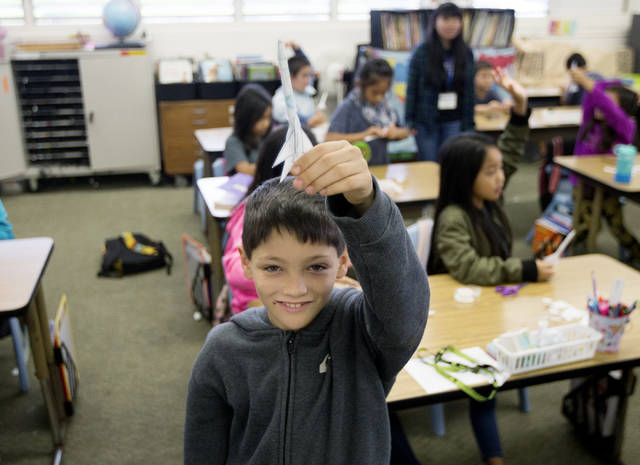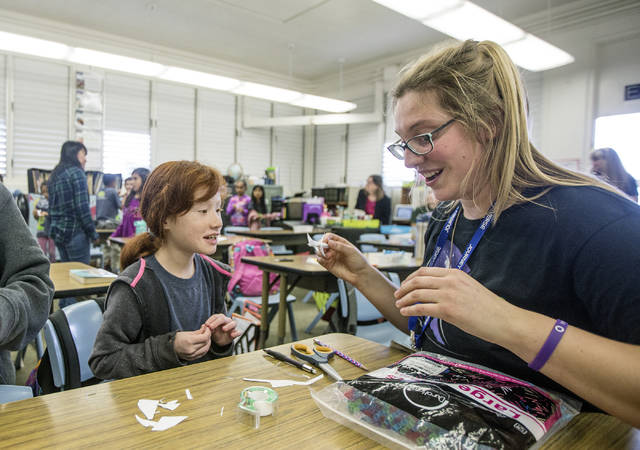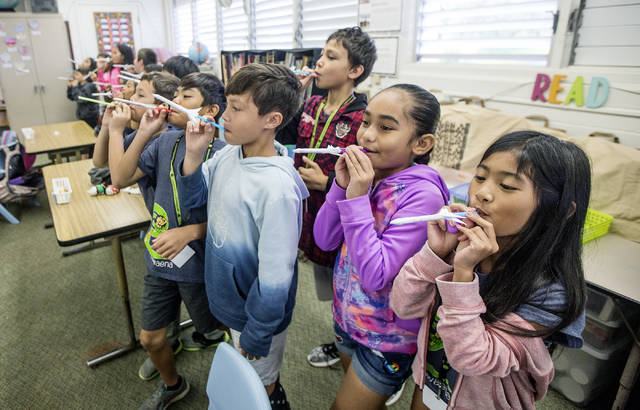It is rocket science: ‘Astronomy educators’ reaching out to Big Island students


Former Gemini Observatory intern Sylvia Kowalski helps third-grader Emily Mejia, 8, make a paper rocket Tuesday during a Journey Through the Universe event at Waiakeawaena Elementary School in Hilo.
HOLLYN JOHNSON/Tribune-Herald

HOLLYN JOHNSON/Tribune-Herald
Third-graders use their breath as fuel to launch their handmade paper rockets Tuesday during a Journey Through the Universe event at Waiakeawaena Elementary School in Hilo.
Dozens of “rockets” were poised for liftoff Tuesday morning as a final countdown began.
Dozens of “rockets” were poised for liftoff Tuesday morning as a final countdown began.
“… 5, 4, 3, 2, 1 — BLASTOFF!” nearly two dozen Waiakeawaena Elementary School third-graders yelled in unison as their paper rockets — engineered using Scotch tape and plastic straws — sailed impressively across their classroom.
ADVERTISING
“You guys are rocket engineers already,” said Sylvia Kowalski, the astronomy educator leading the activity, with a grin.
Kowalski’s hourlong classroom visit at Waiakeawaena was among dozens happening around the island this week as part of the 14th annual Journey Through the Universe Week. The astronomy education and outreach program is organized by Gemini Observatory. It aims to promote science education in schools and inspire students to explore science, technology, engineering and math, or STEM, fields.
The program has about 300 classroom visits planned at schools throughout East and North Hawaii.
It’s stopping for the first time this year at schools in the Ka‘u-Keaau-Pahoa Complex Area. In all, it hopes to reach 9,000 students this year. It eventually hopes to reach students islandwide, said Gemini spokeswoman Janice Harvey.
“The absolute goal is that every child will be scientifically literate,” Harvey said. “Scientific literacy has been a goal of ours from the time we started 14 years ago. We want to inspire the kids to not only know about the world we live in and our universe, but how we came to know that.”
Journey Through the Universe activities are led by “astronomy educators” such as Kowalski, a former Gemini Observatory intern. Topics include classroom visits, workshops, teacher trainings, career panels and public astronomy events. Topics covered during the activities span “the entire gamut,” Harvey said.
“They are just inspiring them about what we know about our solar system,” Harvey said. “And then we talk about career opportunities — that’s really important. We want to make sure that the kids are very aware of the careers (in the field).”
On Tuesday, Kowalski gave students a thorough introduction to rockets. She taught the third-graders how to perform a wiggly “rocket dance” in which they learned various parts of a rocket.
Kowalski also shared some fun facts with the students. She told them, for example, that the fastest rockets can travel 36,000 miles per hour.
“That’s like if you’re here in Hilo and you want to visit a friend in Kona, you could get there in eight seconds,” Kowalski said.
Asher Janeway, 9, said his favorite part of the lesson was learning more about rockets. He said he already knew some of the basics — that “rockets need fuel and that they go into space.” But he said he enjoyed gleaning more details from the astronomy lesson.
Space is “so cool because it’s swirly and there are a lot of stars and stuff,” Asher said.
Alaeyna Vallente, 9, said her favorite part was the rocket dance. She said math is her favorite subject in school because “it’s really fun.”
Space “is really cool because it has no gravity,” Alaeyna said.
Email Kirsten Johnson at kjohnson@hawaiitribune-herald.com.



A good start is to separate science from the ghosts and goblins.
Build TMT.
For the advancement of humankind instead of protesting it under the guise of what some “man made up god” wants.
Get the falsity of religion out of science.